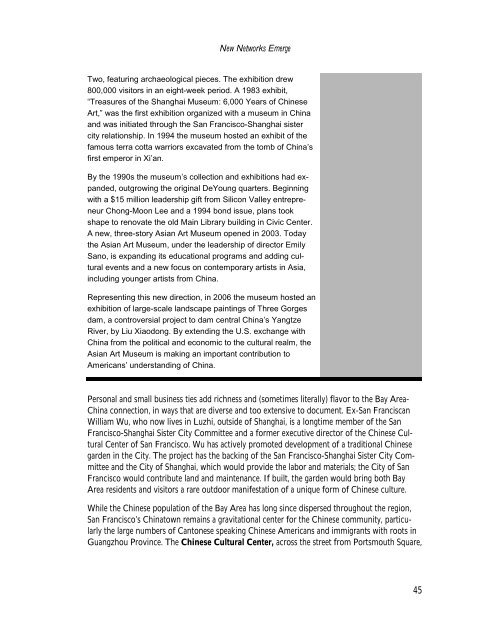Ties That Bind - Bay Area Council Economic Institute
Ties That Bind - Bay Area Council Economic Institute
Ties That Bind - Bay Area Council Economic Institute
You also want an ePaper? Increase the reach of your titles
YUMPU automatically turns print PDFs into web optimized ePapers that Google loves.
New Networks Emerge<br />
Two, featuring archaeological pieces. The exhibition drew<br />
800,000 visitors in an eight-week period. A 1983 exhibit,<br />
“Treasures of the Shanghai Museum: 6,000 Years of Chinese<br />
Art,” was the first exhibition organized with a museum in China<br />
and was initiated through the San Francisco-Shanghai sister<br />
city relationship. In 1994 the museum hosted an exhibit of the<br />
famous terra cotta warriors excavated from the tomb of China’s<br />
first emperor in Xi’an.<br />
By the 1990s the museum’s collection and exhibitions had expanded,<br />
outgrowing the original DeYoung quarters. Beginning<br />
with a $15 million leadership gift from Silicon Valley entrepreneur<br />
Chong-Moon Lee and a 1994 bond issue, plans took<br />
shape to renovate the old Main Library building in Civic Center.<br />
A new, three-story Asian Art Museum opened in 2003. Today<br />
the Asian Art Museum, under the leadership of director Emily<br />
Sano, is expanding its educational programs and adding cultural<br />
events and a new focus on contemporary artists in Asia,<br />
including younger artists from China.<br />
Representing this new direction, in 2006 the museum hosted an<br />
exhibition of large-scale landscape paintings of Three Gorges<br />
dam, a controversial project to dam central China’s Yangtze<br />
River, by Liu Xiaodong. By extending the U.S. exchange with<br />
China from the political and economic to the cultural realm, the<br />
Asian Art Museum is making an important contribution to<br />
Americans’ understanding of China.<br />
Personal and small business ties add richness and (sometimes literally) flavor to the <strong>Bay</strong> <strong>Area</strong>-<br />
China connection, in ways that are diverse and too extensive to document. Ex-San Franciscan<br />
William Wu, who now lives in Luzhi, outside of Shanghai, is a longtime member of the San<br />
Francisco-Shanghai Sister City Committee and a former executive director of the Chinese Cultural<br />
Center of San Francisco. Wu has actively promoted development of a traditional Chinese<br />
garden in the City. The project has the backing of the San Francisco-Shanghai Sister City Committee<br />
and the City of Shanghai, which would provide the labor and materials; the City of San<br />
Francisco would contribute land and maintenance. If built, the garden would bring both <strong>Bay</strong><br />
<strong>Area</strong> residents and visitors a rare outdoor manifestation of a unique form of Chinese culture.<br />
While the Chinese population of the <strong>Bay</strong> <strong>Area</strong> has long since dispersed throughout the region,<br />
San Francisco’s Chinatown remains a gravitational center for the Chinese community, particularly<br />
the large numbers of Cantonese speaking Chinese Americans and immigrants with roots in<br />
Guangzhou Province. The Chinese Cultural Center, across the street from Portsmouth Square,<br />
45








